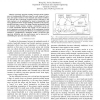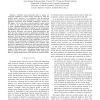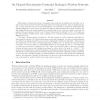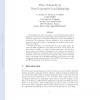INFOCOM
2010
IEEE
13 years 10 months ago
2010
IEEE
—Dynamic spectrum trading amongst small cognitive users is fundamentally different along two axes: temporal variation, and spatial variation of user demand and channel condition....
INFOCOM
2010
IEEE
13 years 10 months ago
2010
IEEE
— Random access protocols, such as Aloha, are commonly modeled in wireless ad-hoc networks by using the protocol model. However, it is well-known that the protocol model is not a...
INFOCOM
2010
IEEE
13 years 10 months ago
2010
IEEE
— In opportunistic networks, end-to-end paths between two communicating nodes are rarely available. In such situations, the nodes might still copy and forward messages to nodes t...
INFOCOM
2010
IEEE
13 years 10 months ago
2010
IEEE
—Peak Signal-to-Noise Ratio (PSNR) is the simplest and the most widely used video quality evaluation methodology. However, traditional PSNR calculations do not take the packet lo...
INFOCOM
2010
IEEE
13 years 10 months ago
2010
IEEE
Multi-channel wireless networks are increasingly being employed as infrastructure networks, e.g. in metro areas. Nodes in these networks frequently employ directional antennas to ...
INFOCOM
2010
IEEE
13 years 10 months ago
2010
IEEE
INFOCOM
2010
IEEE
13 years 10 months ago
2010
IEEE
Abstract—We provide a formal model for the Change Management process for Enterprise IT systems, and develop change scheduling algorithms that seek to attain the “change capacit...
INFOCOM
2010
IEEE
13 years 10 months ago
2010
IEEE
Abstract—We consider a cognitive radio network where multiple secondary users (SUs) contend for spectrum usage, using random access, over available primary user (PU) channels. Ou...
INFOCOM
2010
IEEE
13 years 10 months ago
2010
IEEE
—A fundamental challenge of managing mutable data replication in a Peer-to-Peer (P2P) system is how to efficiently maintain consistency under various sharing patterns with heter...
INFOCOM
2010
IEEE
13 years 10 months ago
2010
IEEE
We investigate the price of anarchy of a load balancing game with K dispatchers. The service rates and holding costs are assumed to depend on the server, and the service disciplin...




